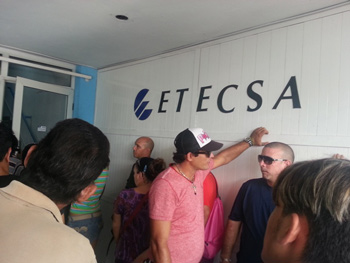Adapting Early to Technology in Cuba
Graham Sowa

HAVANA TIMES — My adventure as an early adapter to what turns out to be old technology began last Monday when I received a much awaited text message from ETECSA, the Cuban phone company, advising that cell phones can now be linked to a Cuban email account.
Rollout is moving at a snail’s pace, which is not much faster than the service itself.
To activate the account I was told to go to any ETECSA phone company store. The next day I arrived at the store at 17 and B in Vedado.
The overly disinterested security guard/line organizer told me that the only ETECSA stores activating the email accounts on cell phones are in the Focsa building, also in Vedado, and at the store at Parque de Curita in Central Havana near Capitolio.
Well then, off to Focsa.
At first I was encouraged by the line at ETECSA at the Focsa building, which was only about 20 people deep.
I marked my spot and started asking what other people knew about the service.
I was able to find out the following, sort of substantiated information:
1) The service can be opened without ¨extra charge¨ given you already have an expensive smart phone, an ETECSA internet account, and prepaid credit in your cell phone
2) Costs of use are 0,01 CUC per 10kb, about 2-3 cents for a longish email with text only. A 1Mb picture, for example, will cost 1.00CUC.
3) The service does not include internet yet, only emails at the @nauta.cu address can be accessed.
4) Not all operating systems support the service. Only people with an Apple or Android operating system were being connected…don’t bother with a Blackberry.
Other than finding out the above information I didn’t make any more progress that day.
The line didn’t advance more than a person or so an hour, mostly because the ETECSA employees are too few and not well trained to handle the demand for this service. Also there were lots of people skipping the line and using their friendship with a worker or making a small bribe to make things move faster for them.
After waiting years for a service like this to become available I didn’t have any qualms about returning to the Focsa building on Friday knowing I would be in a line all morning and maybe some of the afternoon.
The people in line were not hostile and suspicious, which is par for the course in Cuba. On the contrary there was camaraderie between those of us eager to be early adapters in a country that still seems undecided on the prospects of the digital revolution.
We would eagerly wait for someone to come down the steps from the store to see if they had got their phone to work.
After watching my comrades have a success rate of between 30-50% at 2pm it was my turn to spin the roulette wheel of new technology in Cuba.
I had everything set up within an hour; even though the only work the nice ETECSA employees had to do was enter my cell phone number into their computer. I then used their instruction sheet to activate the service on my phone.
After that they asked me to help translate a paragraph into English to explain to tourists that foreign visitors cannot buy SIM cards in Cuba. I happily obliged the favor; eager to make a friend inside of the store and maybe not have to wait in line like a sucker next time.
Of course the service didn’t work right away since the server was down. “Check later,” they told me.
I stepped out of the store unsure of victory or defeat. When the others in the line asked me if I had made any progress I shrugged my shoulders.
When I switched on my cell phone later that night I was delighted to see that, yes!, a network had been detected, an EDGE network to be exact. Amazingly, in addition to now having data service my cell phone had also gone back in time to 2003.
I really shouldn´t speak poorly of the EDGE network. Sure it is slow, but with prices of 1 CUC per 1Mb who would want anything fast?
I Just know that the data network is also using the same network and antennas that can’t deliver a text message in less than 3 hours. This means that speeds are so slow during business hours that coverage is sketchy and some emails bounce.
While I count this as a personal triumph the bigger point should be that the service is prohibitively expensive, even unthinkable, to the average Cuban worker. This explains why I have not heard anyone, not even outside the line in front of the ETECSA store, gossiping about the new service.
This is just another short jolt towards a yet unrealized digital age in Cuba.
